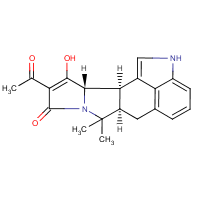Cyclopiazonic acid
Agent Name
Cyclopiazonic acid
CAS Number
18172-33-3
Formula
C20-H20-N2-O3
Major Category
Biological Agents

Synonyms
9H-Pyrrolo(1',2':2,3)isoindolo(4,5,6-cd)indol-9-one, 10-acetyl-2,6,6a,7,11a,11b-hexahydro-11-hydroxy-7,7-dimethyl-, (6aalpha,11abeta,11balpha)- (8CI)(9CI); 9H-Pyrrolo(1',2':2,3)isoindolo(4,5,6-cd)indol-9-one, 2,6,6a,7,11a,11b-hexahydro-10-acetyl-7,7-dimethyl-11-hydroxy-, (6a-alpha, 11a-beta, 11b-alpha)-; [ChemIDplus]
Category
Mycotoxins
Description
Solid; [HSDB]
Sources/Uses
Suspected cause of "kodua poisoning" in humans from eating kodo millet seed in India; Mycotoxin produced by Aspergillus and Penicillium; [HSDB] Produced by Penicillium and Aspergillus species in moldy millet or ground nut meal; Also produced by some strains of Penicillium camemberti used to make gourmet cheese; [Reference #1]
Comments
Toxic to muscles, liver, and spleen; In 90-day feeding studies of dogs, caused anorexia, vomiting, diarrhea, dehydration, and CNS depression with focal ulcerations throughout GI tract; All dogs receiving 0.5 to 1.0 mg/kg died before the conclusion of the study; [HSDB] Causes hepatocellular necrosis and acute tubular necrosis at lethal oral doses in rats; [RTECS] Alters ion transport across cell membranes and causes kodua poisoning with symptoms of giddiness and nausea; [Reference #1]
Reference Link #1
Biomedical References
Exposure Assessment
Half Life
24 hours in market-weight pigs; [HSDB]
Adverse Effects
Neurotoxin
Other CNS neurotoxin
Hepatotoxin
Hepatoxic (a) from occupational exposure (secondary effect) or (b) in animal studies or in humans after ingestion
Diseases, Processes, and Activities Linked to This Agent
Other Information
No other related information on this agent was found.